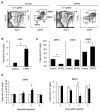Calcium Pyrophosphate Dihydrate Crystals Increase the Granulocyte/Monocyte Progenitor (GMP) and Enhance Granulocyte and Monocyte Differentiation In Vivo
- PMID: 33383835
- PMCID: PMC7794855
- DOI: 10.3390/ijms22010262
Calcium Pyrophosphate Dihydrate Crystals Increase the Granulocyte/Monocyte Progenitor (GMP) and Enhance Granulocyte and Monocyte Differentiation In Vivo
Abstract
Calcium pyrophosphate dihydrate (CPPD) crystals are formed locally within the joints, leading to pseudogout. Although the mobilization of local granulocytes can be observed in joints where pseudogout has manifested, the mechanism of this activity remains poorly understood. In this study, CPPD crystals were administered to mice, and the dynamics of splenic and peripheral blood myeloid cells were analyzed. As a result, levels of both granulocytes and monocytes were found to increase following CPPD crystal administration in a concentration-dependent manner, with a concomitant decrease in lymphocytes in the peripheral blood. In contrast, the levels of other cells, such as dendritic cell subsets, T-cells, and B-cells, remained unchanged in the spleen, following CPPD crystal administration. Furthermore, an increase in granulocytes/monocyte progenitors (GMPs) and a decrease in megakaryocyte/erythrocyte progenitors (MEPs) were also observed in the bone marrow. In addition, CPPD administration induced production of IL-1β, which acts on hematopoietic stem cells and hematopoietic progenitors and promotes myeloid cell differentiation and expansion. These results suggest that CPPD crystals act as a "danger signal" to induce IL-1β production, resulting in changes in course of hematopoietic progenitor cell differentiation and in increased granulocyte/monocyte levels, and contributing to the development of gout.
Keywords: calcium pyrophosphate dihydrate crystals; granulocyte; monocyte.
Conflict of interest statement
The authors declare no conflict of interest.
Figures




Similar articles
-
Inflammatory Potential of Four Different Phases of Calcium Pyrophosphate Relies on NF-κB Activation and MAPK Pathways.Front Immunol. 2018 Oct 9;9:2248. doi: 10.3389/fimmu.2018.02248. eCollection 2018. Front Immunol. 2018. PMID: 30356764 Free PMC article.
-
Fate Mapping via Ms4a3-Expression History Traces Monocyte-Derived Cells.Cell. 2019 Sep 5;178(6):1509-1525.e19. doi: 10.1016/j.cell.2019.08.009. Cell. 2019. PMID: 31491389
-
Identification of an atypical monocyte and committed progenitor involved in fibrosis.Nature. 2017 Jan 5;541(7635):96-101. doi: 10.1038/nature20611. Epub 2016 Dec 21. Nature. 2017. PMID: 28002407
-
Monosodium urate and calcium pyrophosphate dihydrate (CPPD) crystals, inflammation, and cellular signaling.Joint Bone Spine. 2005 Jul;72(4):295-302. doi: 10.1016/j.jbspin.2004.12.010. Joint Bone Spine. 2005. PMID: 15990350 Review.
-
Calcium crystal-associated arthritides.Curr Opin Rheumatol. 1998 May;10(3):273-7. doi: 10.1097/00002281-199805000-00020. Curr Opin Rheumatol. 1998. PMID: 9608333 Review.
Cited by
-
Synovial Fluid from Patients with Osteoarthritis Shows Different Inflammatory Features Depending on the Presence of Calcium Pyrophosphate Crystals.Int J Mol Sci. 2023 Dec 27;25(1):393. doi: 10.3390/ijms25010393. Int J Mol Sci. 2023. PMID: 38203564 Free PMC article.
-
The translational value of calcium pyrophosphate deposition disease experimental mouse models.Front Med (Lausanne). 2024 May 23;11:1417318. doi: 10.3389/fmed.2024.1417318. eCollection 2024. Front Med (Lausanne). 2024. PMID: 38846138 Free PMC article. Review.
References
MeSH terms
Substances
LinkOut - more resources
Full Text Sources
Research Materials

